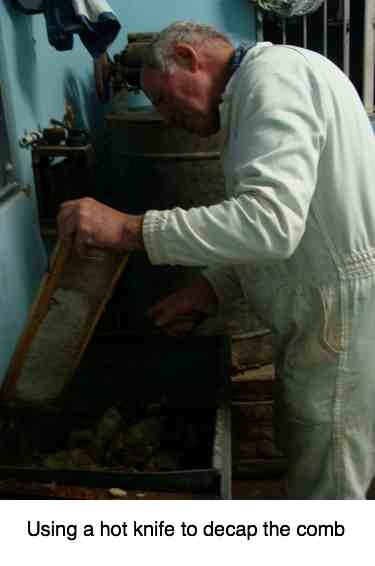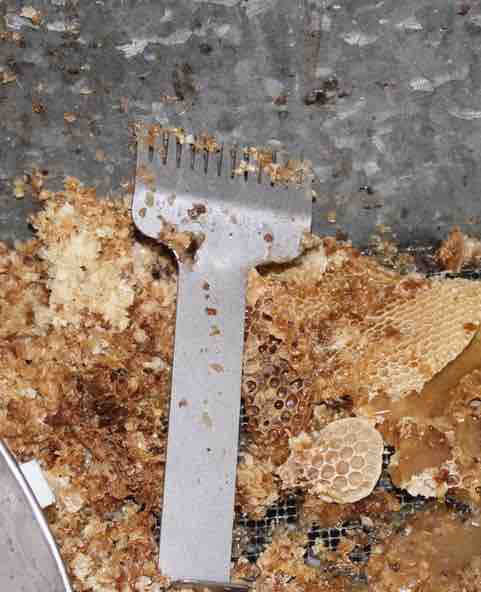- Homepage
- Beekeeping
- Hot Knife Vs Fork Honey Decapping
Hot knife vs fork honey decapping
Hot knife vs fork honey decapping has many pros and cons, especially for the beekeeper wanting to advertise a truly unheated, raw product.
I feel a bit of a turncoat, having used only the hot knife for close on sixty years; and now abandoned it in favour of the fork for decapping honey combs.

This page was last updated by Bernard Preston on 9th March, 2024.
Humans like bees are creatures of habit and they are not always good; somehow we get stuck in our ways. Then, when another keeper suggests a different manner of doing things, we defend our tried and tested method. New innovations always battle to break through our traditionalism.
Change of course is not always for the good, so a certain conservatism is not entirely bad. The death of my trusty decapping knife after sixty years of service was the stimulus to consider something different; and a visit to another beekeeper's honey-room.
The decapping fork was much cheaper than importing a new hot knife. It is also a lot lighter on the arm; less likelihood of getting tennis elbow. It is really a matter of personal preference.
Hot knife vs fork honey decapping

The hot knife vs fork honey decapping debate has slowly settled in my mind in favour of the latter.
The issues involved are:
- Do you want to market a honey that you can truly call raw and completely unheated, not even warmed?
- How long does it take to decap a frame?
- How much honey is wasted? The gleanings usually have to be heated unless you are a meader.
- When comparing the knife vs fork, does one foster better extraction?
- How much wax is produced for new foundation?
- Does either method produce more cappings that clog the filters?
There are no doubt other factors that may be of importance.
I proudly market a raw honey, lightly-filtered and rich in pollen, but Jiminy Cricket was forever pricking my conscience; a small proportion was exposed to the high temperature of the knife. Perhaps it was only 5 percent but it meant that the final product could not be described in all honesty as absolutely unheated.
The only way around that and it was irksome, was to keep the gleanings completely separate from the bulk of the nectar; even then some of my best raw honey would have been exposed to the hot knife.
I soon realised that when comparing hot knife vs fork honey decapping that the former, my long tried and tested method took a lot longer; that alone gave considerable impetus for change. I will do some measurements in the future but I would estimate twice the time.
The fork leaves far less honey in the gleanings.
At this stage I am still uncertain about which is more effective when comparing hot knife vs fork honey decapping. Measurements will follow at some time in the future to see if there is a difference in the extraction.
Likewise the fork produces less wax in the gleanings. In fact that may cause a shortage of new foundation. It does allow for deep stripping of the comb after extraction should one have a need for more.
An unexpected negative was that the fork butchered the combs and produced a lot of fragments that blocked the filter. However this was easily surmounted manually with a flat wooden pancake-spatula.
Whilst my original hot knife was quite light, the newly purchased item was much heavier and tired out the forearm; it was also a good deal hotter resulting in more damage to the honey and frequently having to turn it off. But I do not particularly like the shape of the handle of the fork either and will try some others; that shown in the photo above is much better.
In short at the end of the day, both schools have their ardent enthusiasts who will stick to one or other of the hot knife vs fork honey decapping debate. I am the turncoat who for the present has swapped sides but old habits die hard.
I will not be totally convinced until I am sure as much honey can be extracted from the forked comb as from the one decapped with a hot knife.
Next will be to consider the plastic or steel needle roller tool for honey decapping; I hear that they are better still.
Glycemic index
There's also apparently some research, according to Faithful to Nature[1] that heating honey raises the glycemic-index; that would mean an adverse effect on blood sugar, and make it fattening. A scan of the literature confirms they are right[2].
Overall the insulin response to raw honey is significantly less than that of glucose.
German researchers found that there was considerable variation in different honeys but overall the insulin response was 55% less than a glucose control. The GI of 5 of 6 supplied samples from the beekeepers federation was in the low bracket. The exception was the one from forests which was high in melezitose[2]. Both those from commercial bottlers had very high glycemic indices.
Unfortunately they never stated whether any of the honeys where heated or not.
Clearly this is a complex subject and whilst one can confidently state that the effect of the sugars in natural, raw honey is low on blood glucose one really has little idea of the effect of commercial bottles in the supermarket that invariably have been heated; and often adulterated with corn syrup.
The material expressed on this page is gleaned from the nutritional and environmental literature; it is clearly referenced. A plain distinction is made between the author's opinion and that which is scientifically proven. When in doubt consult your health professional.
To suggest a correction or clarification, write to Dr Bernard Preston here. Contact.
Newsletter
Our newsletter is entitled "create a cyan zone" at your home, preserving both yourself and Mother Earth for future generations; and the family too, of course. We promise not to spam you with daily emails promoting various products. You may get an occasional nudge to buy one of my books.
Here are the back issues.
- Lifestyle and ideal body weight
- What are ultra-processed foods?
- Investing in long-term health
- Diseases from plastic exposure
- Intensive lifestyle management for obesity has limited value
- A world largely devoid of Parkinson's Disease
- The impact of friendly bacteria in the tum on the prevention of cancer
- There's a hole in the bucket
- Everyone is talking about weight loss drugs
- Pull the sweet tooth
- If you suffer from heartburn plant a susu
- Refined maize meal and stunting
- Should agriculture and industry get priority for water and electricity?
- Nature is calling
- Mill your own flour
- Bake your own sourdough bread
- Microplastics from our water
- Alternative types of water storage
- Wear your clothes out
- Comfort foods
- Create a bee-friendly environment
- Go to bed slightly hungry
- Keep bees
- Blue zone folk are religious
- Reduce plastic waste
- Family is important
- What can go in compost?
- Grow broad beans for longevity
- Harvest and store sunshine
- Blue zone exercise
- Harvest and store your rainwater
- Create a cyan zone at your home
Useful links
When browsing use right click and "Open Link in New Tab" or you may get a bad gateway signal.
Did you find this page interesting? How about forwarding it to a friendly book or food junkie? Better still, a social media tick would help.
- Homepage
- Beekeeping
- Hot Knife Vs Fork Honey Decapping
Address:
56 Groenekloof Rd,
Hilton, KZN
South Africa
Website:
https://www.bernard-preston.com